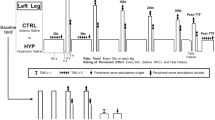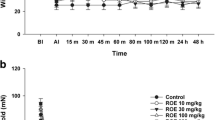Abstract:
Objective: We employed the 'delayed onset of muscle soreness' (DOMS) and the 'hypertonic saline' muscle pain models in combination with muscle microdialysis to evaluate the role of potentially algesic substances (lactate, glutamate, prostaglandin E2 (PGE2), nitric oxide (NO) and substance P (SP)) in the development of human muscle pain. Methods: DOMS was induced by 2 sets of 50 concentric/eccentric contractions of the calf muscles 24 h before the start of microdialysis. During microdialysis pain was stimulated through calf muscle contractions (dorsal and plantar flexions of the foot). Hypertonic saline was injected into the biceps muscle (5 × 200 μl 5.8 % NaCl, 2 min interval) during dialysis. The calf (no treatment) and biceps (normal saline) of the other side was used as control. Results: Both models reliably induced muscle pain with similar intensities as assessed by visual analog scale. The DOMS exercise caused an increase of lactate in serum and the calf muscles of the DOMS leg. In addition, glutamate, PGE2 and substance P dialysate concentrations increased following contraction-induced pain stimulation (peak concentrations 125 ± 20 μM, 239 ± 45 pg/ml and 60 ± 11 pg/ml for glutamate, PGE2 and SP, respectively). This increase did not occur in the control leg (peak concentrations 97 ± 12 μM, 114 ± 26 pg/ml and 46 ± 9 pg/ml for glutamate, PGE2 and SP, respectively). Concentrations of nitric oxide were lower in the DOMS than control leg, particularly during the first 4 h of microdialysis. Injection of hypertonic saline into the biceps muscle caused a significant increase of dialysate glutamate concentrations (peak 50 ± 3 μM) whereas glutamate remained constant after injection of normal saline (mean 26 ± 1 μM). Injection of hypertonic saline had no effect on lactate, PGE2 or NO levels. Conclusion: Our data support the notion that an inflammatory reaction may be involved in muscle soreness following eccentric exercise, whereas the injection of hypertonic saline into the muscle probably directly stimulates muscle nociceptors and causes glutamate release.
Similar content being viewed by others
Author information
Authors and Affiliations
Additional information
Received 13 July 2001; returned for revision 15 October 2001; returned for final revision 14 March 2002; accepted by M. J. Parnham 9 April 2002
Rights and permissions
About this article
Cite this article
Tegeder, I., Zimmermann, J., Meller, S. et al. Release of algesic substances in human experimental muscle pain. Inflamm. res. 51, 393–402 (2002). https://doi.org/10.1007/PL00000320
Issue Date:
DOI: https://doi.org/10.1007/PL00000320




